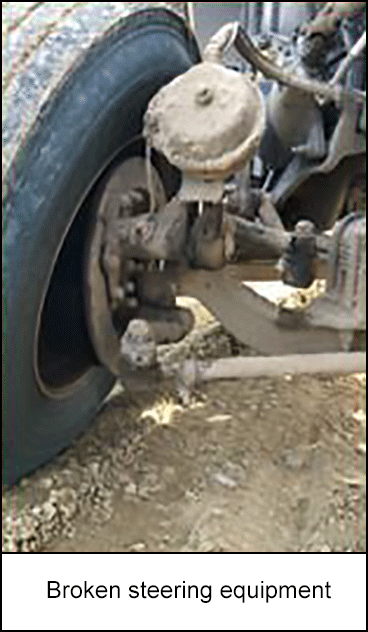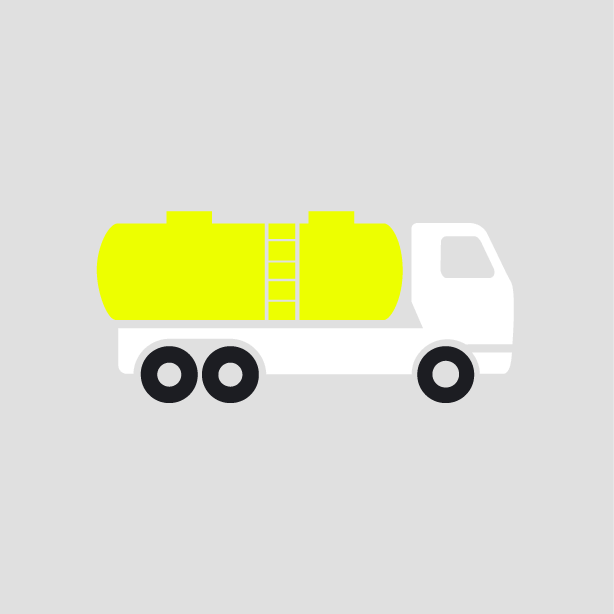-
What happened?
A Super-B hauler truck completed unloading and proceeded to leave a location.
The driver identified that it felt like the brakes were dragging on the front driver’s side wheel.
The driver stopped, adjusted the brakes and proceeded to back up. While backing up, the wheel detached from the axle.
Although there was only a moderate degree of asset damage and no injuries, this event had high potential to cause a catastrophic event resulting in loss of life, permanent disabilities and/or total asset loss.

-
Why did it happen?
- During the pre-trip inspection, the hub oil level was not identified as low. The hub is believed to
have been run dry for a period and left un-repaired. - The un-serviced bearing and hub were run unlubricated, which allowed the hub to fail catastrophically due to the excess friction between the bearing/hub and axle. The wheel bearing failed, causing the wheel hub to become disconnected from the axle.

- During the pre-trip inspection, the hub oil level was not identified as low. The hub is believed to
-
What did they learn?
- Preventative maintenance tasks must follow manufacturer, regulatory and company standards to ensure assets are safe and ready for use.
- There is a legal requirement for commercial vehicles to undergo regular inspections. These must be documented and should be shared with maintenance personnel.
- Asset users must ensure inspections (including the pre-trip) are thorough, documented and shared with the appropriate department. Recording and reporting inspections regularly ensures simple items, such as an oil leak, do not lead to a catastrophic failure that can cause serious damage to equipment and place users and members of the public or worksite at risk.
- Regular mechanical inspections, as per provincial and/or federal regulations, should be completed, documented and action items should be corrected.

-
Ask yourself or your crew
- How can something like this happen here (e.g. on our site)?
- What safety measures (i.e. procedures, controls/barriers) do we have in place to mitigate the risk?
- How do we know the risk controls/barriers are working?
- What improvements or changes should we make to the procedures, controls/barriers or the way we work?

Add to homescreen
If you want to add this app to home screen tap and then ‘Add to Home Screen’.
Content name
Select existing category:
Content name
New collection
Edit collection
What happened?
A Super-B hauler truck completed unloading and proceeded to leave a location.
The driver identified that it felt like the brakes were dragging on the front driver’s side wheel.
The driver stopped, adjusted the brakes and proceeded to back up. While backing up, the wheel detached from the axle.
Although there was only a moderate degree of asset damage and no injuries, this event had high potential to cause a catastrophic event resulting in loss of life, permanent disabilities and/or total asset loss.

Why did it happen?
- During the pre-trip inspection, the hub oil level was not identified as low. The hub is believed to
have been run dry for a period and left un-repaired. - The un-serviced bearing and hub were run unlubricated, which allowed the hub to fail catastrophically due to the excess friction between the bearing/hub and axle. The wheel bearing failed, causing the wheel hub to become disconnected from the axle.
What did they learn?
- Preventative maintenance tasks must follow manufacturer, regulatory and company standards to ensure assets are safe and ready for use.
- There is a legal requirement for commercial vehicles to undergo regular inspections. These must be documented and should be shared with maintenance personnel.
- Asset users must ensure inspections (including the pre-trip) are thorough, documented and shared with the appropriate department. Recording and reporting inspections regularly ensures simple items, such as an oil leak, do not lead to a catastrophic failure that can cause serious damage to equipment and place users and members of the public or worksite at risk.
- Regular mechanical inspections, as per provincial and/or federal regulations, should be completed, documented and action items should be corrected.
Ask yourself or your crew
- How can something like this happen here (e.g. on our site)?
- What safety measures (i.e. procedures, controls/barriers) do we have in place to mitigate the risk?
- How do we know the risk controls/barriers are working?
- What improvements or changes should we make to the procedures, controls/barriers or the way we work?
Published on 16/04/23
1683 Views
A driver felt like the brakes were dragging on the front driver’s side wheel. He stopped, adjusted the brakes and proceeded to back up. While backing up, the wheel detached from the axle.
Original material courtesy of Energy Safety Canada













